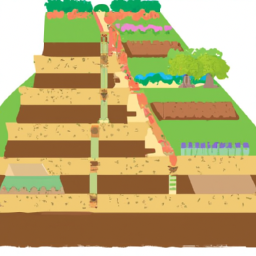How To Build Tiered Garden On A Slope
Table of Contents []
How To Build A Tiered Garden On A Slope
Introduction
A tiered garden on a slope can be tricky to build, but the extra effort is well worth the amazing views and creative options it affords. Many gardens are threes equal tiers, but there's no limit to the complexity or the number of tiers you can create. By taking the time to understand and plan the build, a tiered garden can bring a stunning advantage to almost any sloping terrain.
In this article we will walk through 8-12 topics to understand the process - from site preparation and structural considerations, to the types of plants to choose and the landscaping stones that will be used - we'll explore everything you need to know to build the perfect tiered garden on a slope.
Topic 1: Measure the Slope
The first step is always the most important: measuring the slope. It's critical to understand the amount of gradient in order to plan the tiers and make sure that the feature will be safe and stable in the long term. Once the measurements have been taken, you'll have a better understanding of the level of effort the build will require.
Popular Subtopics:
H2: Using a Topographic Map
A topographic map will give you a real-time view of the layout of the land. Measure the slope and drops between tiers to make sure you don't create too dramatic a drop.
H3: Understanding Grading Concepts
Grading a slope can be complex because the site has to be contoured carefully to build up terraces for the tiers. In each place where a tier is to be formed, a flat surface is required to ensure the stability of the tiers.
H3: Taking Measurements
Before any other work can be done you'll have to take precise measurements of the slope. This will require a digital level to prevent any errors.
Topic 2: Site Preparation
Now that you have an understanding of the site's layout - what's in store for the excavation phase? It's becoming increasingly popular to hire an excavation team to help with the project. With the right prep work and the help of a professional, you can create a stable foundation of terraces for the tiers.
Popular Subtopics:
H2: Leveling the Site
Prior to construction the area must be leveled. This prepares the layout for the installation of the terraces and ensures that the project stays within the project's parameters.
H3: Digging the Tiers
Remove the existing soil from the foundation and compile it in the bottom of each tier. Use a level to ensure the foundation is even.
H3: Incorporating Artistic Details
To create visual interest, incorporate subtle details into the design like curves and arches. If the slope has open areas there's an opportunity to form contours into the stone for visual texture.
Topic 3: Structural Considerations
Once the foundation is in place it's important to decide how the tiers will be reinforced and stabilized. The structural elements you decide to incorporate will determine how durable and stable the design is in the long run.
Popular Subtopics:
H2: Installing Anchors
Stone anchors are the best way to reinforce the tiers, as they connect the terrace walls and create a more secure build.
H3: Decorative Retaining Walls
Brick, stone, and timber retaining walls are a popular option for slopes. This type of wall is typically made up of larger stones in the bottom and smaller stones in the top for decorative flair.
H3: Adding Facing
Facing is essential for keeping the soil in place and slowing run-off on the slope. Place the facing against the top of the wall and secure it with a dry stack to further protect the soil.
Topic 4: Plant Selection
When selecting plants for a tiered slope it's important to consider the amount of sunlight and the level of soil drainage. Be aware that the sides of a tiered slope are typically dry and can be challenging to plant.
Popular Subtopics:
H2: Choosing the Right Trees
For a long-term landscape design, choose trees that can be pruned and shaped over time as their natural shape develops. Species such as birch, oak, maples, and willow are all perfect for cultivation.
H3: Low-Maintenance Plants
Groundcover plants such as phlox, ivy, and ferns are an excellent option for slopes. As a bonus their bright colors add a cheerful touch to the landscape.
H3: Introducing Color
To add drama to the landscaping, select species that thrive in deep shade and flowers that bloom in the summer like impatiens, foxglove, and marigolds.
Topic 5: Landscaping Stone
Adding landscaping stone to the terraces adds an interesting texture to the tiers and will help to secure soil.
Popular Subtopics:
H2: Types of Materials
Choose from a variety of natural stone materials such as flagstone, slate, river rock, and bluestone. Consider the colors that will complement the plants you select, as well as the slope.
H3: Pedestals and Slabs
Pedestals form an intricate multi-level landscape. If you'd like to create visual interest without too much effort, then opt for slabs instead.
H3: Variety of Effects
Finally, consider the different uses of landscaping stone - from paths, to meadows, and walls. Different types of stone can be used to create a variety of effects.
Conclusion
Building a tiered garden on a slope might seem like a daunting task, but with the right planning and resources it is completely achievable. From site preparation, structural considerations, plant selection, and landscaping stones, we have covered the 8-12 topics you need to keep in mind to create the perfect tiered garden on a slope.
Taking the time to plan the tiers and measure the slope, will ensure that the build is safe and secure against elements. With careful attention to detail and a creative eye, you can build a garden with amazing views and a stunning feature that will leave your neighbors green with envy.

Previous Page
Next Page
